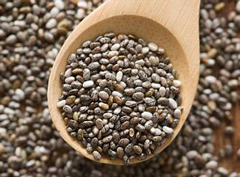
The rediscovery of ancient foods such as quinoa has opened the door for other forgotten plants – such as prickly pear cactus and chia seeds – to go global as well.
Both chia seeds and prickly pear cactus were foods used by the ancient Aztecs, while quinoa was consumed primarily by the Incas.
The use of chia seeds as an ingredient has continued to grow, with a tenfold increase in ingredient penetration globally between 2009 and 2014, according to Mintel. North America saw the majority of chia seed food and drink launches in 2013, with 47 percent of launches in the U.S. and 12 percent in Canada, compared to 18 percent in the Asia Pacific region and 11 percent in Europe.
Chia seeds are being primarily used in food products, but recent years have seen an increase of chia seeds in beverages as well. In 2013, 12 percent of products launched with chia seeds were in the beverage category, up from zero in 2009. Meanwhile, prickly pear ingredients are most commonly found in beverages, with 57 percent of all food and drink products using a prickly pear ingredient between 2009 and 2013 launched in the beverage category.
“Although chia, which is a complete protein, has been rumored to reduce food cravings, lower blood pressure and aid in weight loss, studies have been unsuccessful at validating these claims,” said Stephanie Pauk, global food science analyst at Mintel. “That said, manufacturers should keep claims for chia products focused on its nutritional value rather than unproven health claims. Since 65 percent of U.S. consumers are trying to include plenty of fiber in their diet, manufacturers could use chia’s high fiber content to help set it apart in beverages, as less than 1 percent of all beverages launched in 2013 used a high fiber claim.”
Although fewer than 100 products have been launched globally with a prickly pear ingredient between 2009 and 2013, the health benefits as well as the plant’s resilient nature make it a promising superfruit in the upcoming years, especially given the increasing number of droughts.
The plant is also used traditionally in Mexico as a hangover cure and to address a range of health conditions, including blood pressure, ulcers and fatigue. The Food and Agriculture Organization of the United Nations (FAO) has even suggested that prickly pear could be an effective feed for livestock.
“Both chia and prickly pear have a unique opportunity to position themselves as the next big ‘it’ ingredient, given their health benefits and diversity of uses,” Pauk said. “For chia, even though it is technically an oilseed, the focus can be on pairing it with ancient grains, as U.S. consumers are becoming more interested in those. In the U.S., 44 percent of U.S. consumers have eaten ancient grains. Using antioxidant-rich and often gluten-free ancient grains such as quinoa or buckwheat with chia could strengthen its healthy positioning. For prickly pear, manufacturers can consider using it as a natural source of taurine and antioxidants for energy drinks or as an added source of fiber.”

